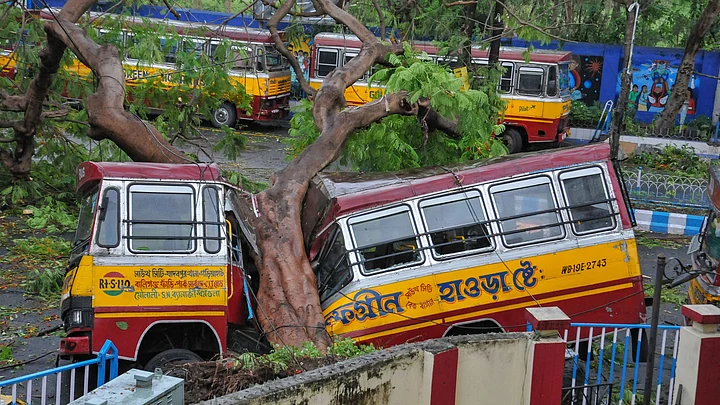One more time the country is being put to test as a natural calamity in the form of a cyclone named Amphan ravages two big states – West Bengal and Odisha – with a collective population of over 135 million. Amidst the coronavirus outbreak, the challenge, however, is dual and way more severe.
Initially termed a "super cyclone", Amphan was moving with a speed of 220 to 230 kilometers per hour, covering an area of over 600 km and measuring 15 kilometres in height before it hit land on the afternoon of Wednesday, 20 May. Such devastating speeds made Amphan the second 'super cyclone' in the Bay of Bengal.
Before this, another such cyclone was experienced 21 years ago in 1999, which, to this date, is among one of the worst natural disasters in India. It had claimed more than 9,500 lives.
The frightening visuals of uprooted trees, flooded roads, damaged electricity poles, dark clouds, thunderstorms, objects flying with an unimaginable speed, the wind blowing off roofs of houses and people screaming for help from both the states affected by Amphan, evoke the memories of the 1999 Odisha Cyclone.
The Horror of 1999
Back then, the intensity of the storm, with 912 milibar air pressure at its centre, was so fierce that it damaged over 15 lakh houses, fully destroyed more than 7.4 lakh houses, washed away hundreds of villages and killed more than 3 lakh animals. Such high air pressure, experts say, means energy equivalent to hundreds of atomic bombs.
As a result, even after making landfall, the super cyclone retained the intensity leading to heavy rains for two long days.
Over 13 million people, including over 3 million children and nearly 3.5 million senior citizens, became victims of the destruction caused by it, according to a UNDP, Odisha Disaster Management Authority and Utkal University report cited by Hindustan Times.
The diameter of the 1999 super cyclone was 200 km. It had first originated as a depression in the Andaman sea but strengthened to an intense storm and took a northwesterly path.
Torrential rains and tidal waves created by it had caused widespread flooding, leaving agricultural lands deprived of cultivation for months to come. The deadly cyclone caused damage worth around $2.5 billion in the state.
Data and numbers, however, can't possibly represent the suffering of people living in the affected areas. For many, it meant losing their livelihoods, homes, and loved ones. In the aftermath, many diseases spread throughout the entire state.
The warnings from the weather department had come early as they did in the case of Amphan, but the danger was underestimated in October 1999 and with the paucity of resources, the government couldn't minimise the damage. The state had predicted that two important cities, Bhubaneswar and Cuttack, wouldn't be affected by the storm but on the evening of 29 October, both the cities got severely affected.
According to an archived Indian Express report, even the then Chief Minister of the state, Giridhar Gamang didn't take the threat seriously at first and bizarrely, consulted his astrologers. It is only after the damage was done that he could phone the central government for help. In addition, officials failed at convincing people to move to a safer place.
According to a report in the World Economic Forum, Odisha (known as 'Orrisa' back then), had just 75 shelters with a capacity of around 1,000 people each.
After the super cyclone wreaked havoc, Odisha took a long time to recover and also to learn from its mistakes.
Learnings from 1992
Odisha has a long history of cyclones and natural disasters. The year 1999 was a learning for all. After the disaster, the state's disaster management skills advanced and the results can be seen in the case of cyclones that followed after.
Many have lauded the state's management during the time of Cyclone Phailin in 2013, Cyclone Hudhud in 2014, Cyclone Titli in 2018 and Cyclone Fani in 2019.
In 21 years, the state has indeed come a long way but there is still a long road ahead as the geographical location of Odisha along with other northeastern states falls in a disaster-prone area.
During Fani last year, the government had evacuated more than a million people before the cyclone could make landfall. The weather department's predictions, too, were accurate and helped the government create an effective plan. In the case of Amphan as well, 5 lakh people were evacuated in West Bengal and 1,58,640 people in Odisha before landfall.
This was perhaps possible because two months after the super cyclone hit in 1999, the Odisha State Disaster Management Authority was set up and over 1,000 shelters were reportedly built in the state in the years that followed. By 2001, Odisha Disaster Rapid Action Force was also set up to perform rescue operations and relief work.
Apart from building infrastructure, effective communication and coordination plans, too, ensured minimum damage.
In West Bengal, people remember Cyclone Bulbul that had battered the state last year. Just like Amphan, Bulbul, too, had hit the Sundarbans – the world's largest mangrove forest.
With lessons from the past, both the states, in the times of COVID-19, would look at effective ways to restore the damage and deal with the aftermath from here on.
(At The Quint, we question everything. Play an active role in shaping our journalism by becoming a member today.)
